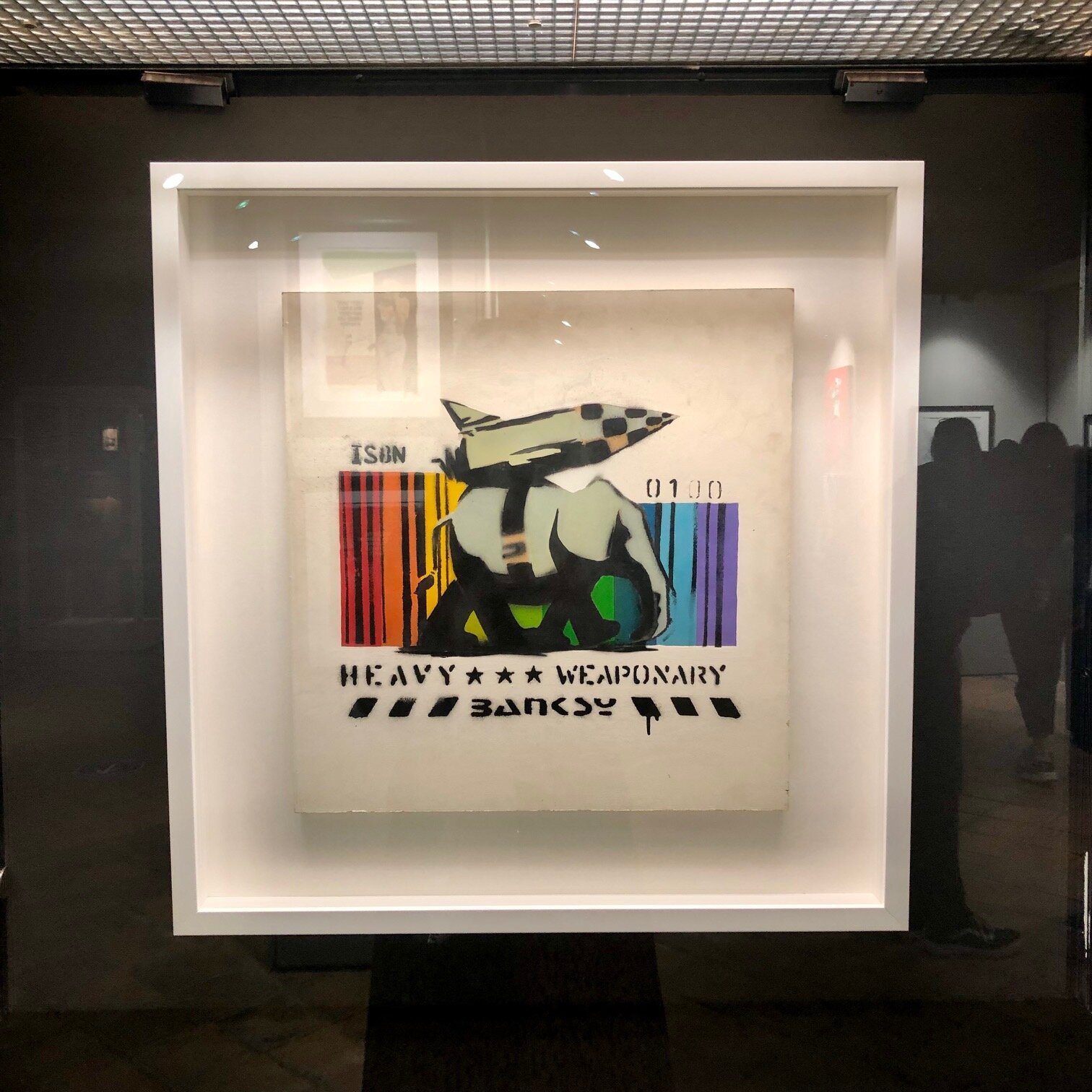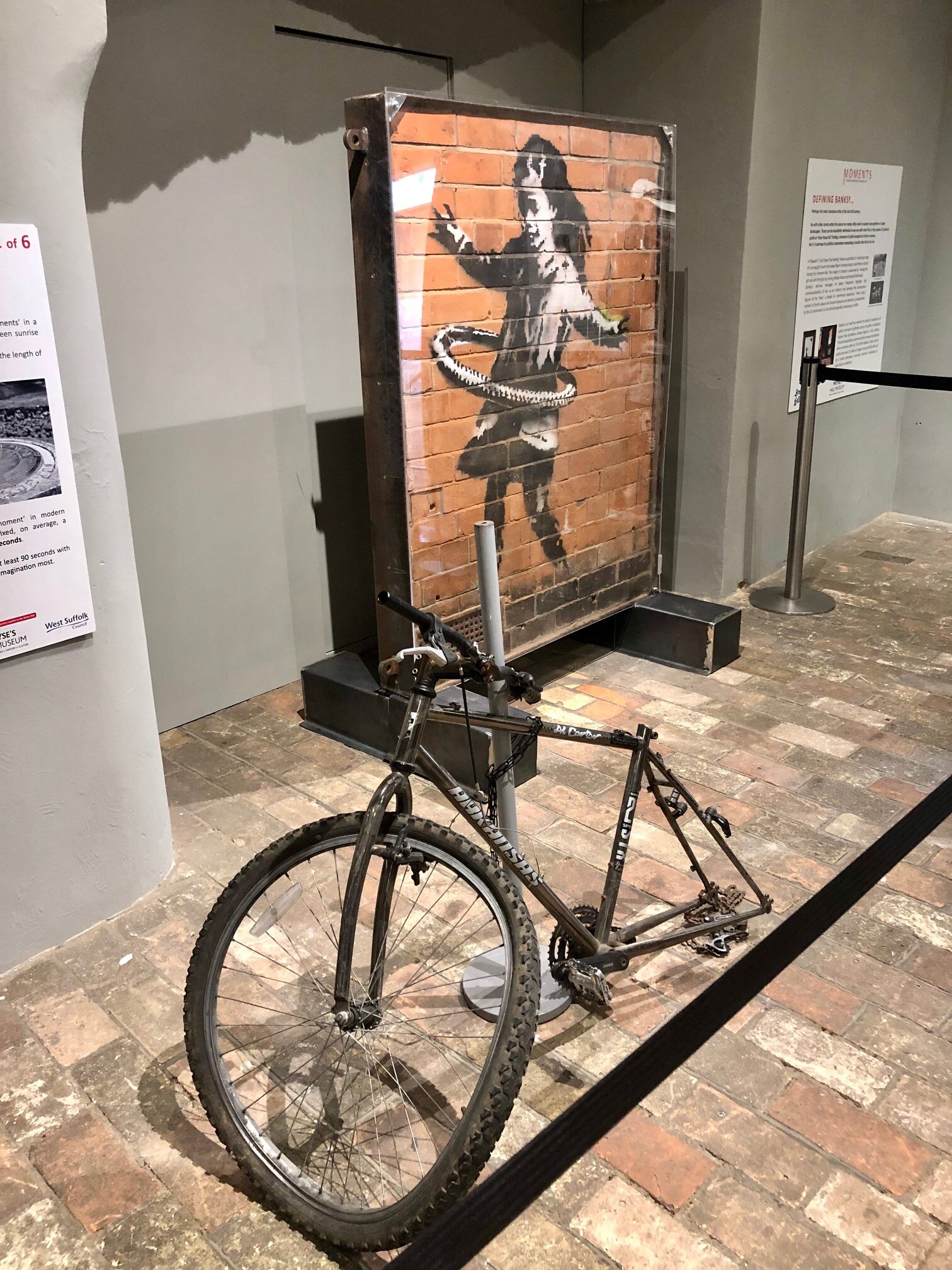How Does Banksy Make Money?
Banksy is the anonymous British street artist who has captured the world's imagination with his provocative stencil art and subversive stunts.
From his early roots spray-painting buildings in Bristol to becoming a global phenomenon, Banksy has turned the concepts of anonymity and anti-establishment art into a lucrative business model.
While the secrecy around his identity adds intrigue, it also raises questions - just how does Banksy, an anonymous street artist make money from guerrilla public art? The answer lies in Banksy's innovative ability to create scarcity value and a seamless brand experience for his dedicated collectors.
Table of Contents
1. Primary Income Source: Banksy Print and Limited Edition Sales
2. High-Value Private Art Sales to Select Collectors
3. Other Banksy Income Sources
1. Primary Income Source: Banksy Print and Limited Edition Sales
A major income source for Banksy is the sale of limited edition prints and artworks, which he sells directly through his website Pest Control.
This direct sales model allows him to strictly control the supply and intentionally create scarcity in the market for his work.
Some key facts about Banksy's lucrative print and limited edition sales business:
His most exclusive signed limited edition prints routinely sell for £20,000 to over £40,000 each when initially released
He also offers lower-cost but still limited open edition prints that typically range from £500 to £1,500 per print. For each print edition, he only releases very small quantities - usually just a few dozen up to a couple hundred prints maximum
By restricting the supply to scarce, limited numbers and eliminating any galleries or middlemen, Banksy is able to keep the full profits from these direct-to-collector sales rather than having to split the earnings. Even his lower-priced open edition offerings command premium values precisely because of their scarcity and connection to Banksy's iconic brand.
This airtight control over the primary market rollout of new Banksy print and art editions is a crucial revenue stream. It allows him to continue feeding insatiable collector demand through disciplined supply control - consistently releasing just enough new material to drive fevered sales without oversaturating the market.
It's a masterclass in using basic economics to manufacture scarcity value.
2. High-Value Private Art Sales to Select Collectors
While the limited edition prints provide a steady income stream, it's Banksy's sales of entirely unique, one-of-a-kind original artworks that generate his biggest windfall paydays.
Reports estimate that the anonymous artist only needs to privately sell around 10 to 20 of his major original pieces annually to fund his entire operation.
Some of Banksy's most famous and lucrative private original art sales in recent years include:
"Devolved Parliament" - This massive work satirizing the British political system sold for a staggering $12.2 million in 2019, setting a new auction record price for a Banksy piece.
"Love is in the Air" - The iconic image of the protestor throwing a bouquet of flowers fetched $12.9 million when it was sold privately in 2021.
The anonymous $25 million purchase and re-donation of "Game Changer" - This tribute piece to Britain's National Health Service heroes was snapped up for a staggering $25 million in 2020, with the anonymous buyer immediately re-gifting it to the NHS.
Banksy's savvy decision to directly broker these major original art sales himself to a tight circle of trusted, elite collectors completely bypasses any third-party galleries or auction houses. This strategic move ensures he captures every single penny of the often eight-figure prices his most significant pieces now command.
By only releasing roughly a dozen or so of his rarest, most premium original works each year through these private transactions, Banksy is able to keep demand, and sale prices, at a perpetual fever pitch amongst his top-tier collectors.
3. Other Banksy Income Sources
Published Books
In addition to his lucrative art sales, Banksy has found commercial success by publishing books that showcase his iconic street art in printed form.
His bestselling titles like "Wall and Piece" give fans a way to own a permanent collection of his most famous and provocative public art interventions.
These books transform Banksy's guerrilla outdoor pieces into polished coffee table books that can be sold and distributed globally through traditional publishing channels. It opens up a whole new revenue stream for the artist to monetize his work.
Films/Documentaries
Banksy has also capitalised on his myth and infamy through film projects. Most notably, his 2010 documentary "Exit Through the Gift Shop" was an unexpected critical and commercial smash hit.
Despite its guerrilla low-budget roots, the film about the enigmatic street artist ended up being nominated for an Academy Award and grossing over $5 million at the box office worldwide. Between distribution deals, home video sales, and building more mainstream intrigue around Banksy, films have been another lucrative medium.
Banksy Merchandise
In addition to his artwork, Banksy has shown the business savvy to create various limited edition merchandise products that tie back to his specific artistic stunts or exhibits.
From exclusive t-shirts and prints only available at his shows, to limited vinyl figurine toys depicting his most famous artworks, Banksy's merch game allows fans to own an affordable piece of his brand. He's essentially created an entire product line around himself as a lifestyle brand.
Special Projects
Banksy has also earned significant paydays by being commissioned for unique, high-profile special projects by organizations looking to leverage his cultural clout.
In 2022, he was tapped by Ukraine's government to create an NFT collection that could be auctioned off to raise over $100 million for their war relief efforts. Given the artist's anti-establishment persona, these types of boundary-pushing blockchain projects represent innovative ways he can capitalize on demand for his work.
So while Banksy's multi-million dollar original artworks and print sales are his primary revenue engines, the anonymous artist has demonstrated an impressive ability to monetize his brand across publishing, film, consumer products and even emerging digital realms like NFTs. It's a true 360-degree business model built around stringently controlling the supply and distribution of his creations to induce scarcity - regardless of the ultimate platform or medium.
4. Anonymous Success, But No Cut of Secondary Market
One of the most fascinating paradoxes of Banksy's multi-million dollar business is that he intentionally does not receive any cut of the profits from the thriving secondary market where his pieces are frequently resold at astronomical prices through auctions and private dealers.
While iconic works like his "Girl With Balloon" have commanded well over $25 million at these secondary resales, Banksy's strict adherence to anonymity means there is no way for him to claim any portion of these incredibly lucrative resale profits.
It's a prime example of how his anti-establishment principles clash with capitalism - he's wilfully leaving millions on the table.
Rather than trying to cash in on the heightened demand and record prices his works fetch on the secondary circuit, Banksy has instead chosen to make his fortune through a primary sales model that plays by his own rules. This includes:
Feeding rabid collector demand by only releasing extremely limited and scarce new offerings directly through his own authorized channels like Pest Control
Bypassing any middlemen galleries or auction houses to keep 100% of the sales prices by selling straight to collectors
Reinforcing the authenticity and air of mystery around the Banksy brand mystique through retaining strict anonymity
As one of the most coveted, valuable, and expensive artists alive today, with a conservatively estimated net worth over $50 million, Banksy has undeniably cracked the code of commercialising his subversive, guerrilla street art style into a highly lucrative enterprise. But he's achieved that immense success strictly on his own rebellious terms, without compromising his anti-establishment ideals.
It's an unorthodox model that defies conventional thinking in the fine art world. Yet by intentionally forgoing any income from the white-hot secondary market, Banksy has perhaps made himself and his brand even more rarefied and valuable on the primary market he strictly controls. It's an audacious and paradoxical strategy, but one that has paid off immensely for the anonymous artist.
5. Smart Brand Management
In an ironic way, Banksy's apparent lack of interest in conventional wealth or art world validation has become his greatest asset for maintaining relevance, scarcity, and a thriving business. When it comes to monetising guerrilla street art while staying true to anti-establishment roots, he's created his own self-sustaining playbook for success.
Banksy may be faceless and pseudonymous, but his ability to turn anonymity into a multi-million dollar revenue stream is the ultimate proof that his infamous line "There is nothing more dangerous than someone who wants to make the world a better place" can apply to revolutionary art and ingenious business acumen.
I hope you have found this blog post about Banksy interesting and enjoyable. To find out more about other great artists, read here:
If you have any questions or comments, please email me at sarahransomeart@gmail.com.











